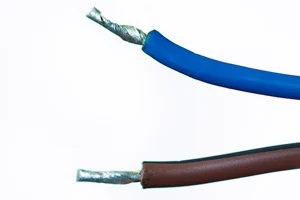In electrical applications like cable assemblies and wire harnesses, choosing stranded wire vs solid wire will depend on the job requirements. The physical differences between the two wires are straight forward enough: a solid wire consists of a solid metal core while stranded wires are made of a quantity of thinner wires that are twisted together into an organized bundle.
In choosing the right wire to use, there are a handful of considerations and pros and cons that will drive the decision, but the key factors are:
- Amperage load and application
- Gauge of wire
- Type of metal that will be used
- Costs
Both stranded and solid wires are used by engineers in a wide variety of cases. In any case, there are advantages and disadvantages of stranded wire vs. solid wire that lead to selecting one over another for each particular application.
Stranded Wire
Because they are bundled, stranded wires are relatively more flexible, intricate, and delicate. They are better suited for indoor use on circuit boards, speaker wires, electronic devices, etc., where bending and twisting are necessary to connect electronic components. For example, an ideal application of stranded wire is in a car door where frequent bending will occur.
Stranded Wire Pros
The bundled braids of stranded cable offer a few acute benefits over solid wire:
- Flexible
- Malleable
- Will not split or sever
Stranded Wire Applications
Stranded wires are more suited to indoor applications where bending and twisting are necessary to connect electronic components like:
- Circuit boards
- Speaker wires
- Electro mechanical assemblies
Solid Wire
 Solid wire is heavier, made for all-weather conditions, is anti-corrosive, rugged, and can withstand frequent, but minimal movement. An ideal application of solid wire would be carrying power through a building structure, as this requires a high current, little movement, and long-lasting durability.
Solid wire is heavier, made for all-weather conditions, is anti-corrosive, rugged, and can withstand frequent, but minimal movement. An ideal application of solid wire would be carrying power through a building structure, as this requires a high current, little movement, and long-lasting durability.
Solid Wire Pros
- Weather-resistant
- Anti-corrosive
- Low cost
Solid Wire Applications
Solid wires are more suited for outdoor or heavy-duty applications where higher currents and more rigid durability are required.
- Building infrastructures
- Vehicle controls
- Outdoor applications
Considering Current in Stranded vs Solid
Electricians must select the appropriate gauge of wire to use based on the amperage load and application of the project. This is determined by the current frequency that passes through the wire. As electrical currents pass through wires, a skin effect occurs. That part of the current closest to the outer layer of the wire, the ‘skin’ area, is where electricity travels along the outside surface and is subjected to magnetic fields, tends to dissipate into the air. Power dissipation is an ever-present challenge for electricians & engineers. Because of its thickness, solid wire has a decreased surface area that reduces dissipation. Because of the given thickness of stranded wire, i.e., it’s thinner, there are more air gaps and a greater surface area in the individual strands of wire. Therefore, it carries less current than similar solid wires can. With each type of wire, insulation technologies can greatly assist in reducing power dissipation.
Stranded vs Solid: Which is Best?
In terms of cost, simplicity, and durability, the advantage goes to solid wire. As a single strand of thick wire it is easy to manufacture and exceptionally resistant to damage. The thickness also helps to prevent electronic interference and limit the skin effect caused by magnetic fields on the wire’s surface. Its disadvantage is in its lack of malleability and strength. Once a thick copper wire is twisted, it’s subjected to splitting or severing. Stranded wires are advantageous for applications that require a great deal of intricate snaking, bending, reshaping, and movement such as in vehicles/robotics or electronic circuit boards.
In choosing stranded wire vs. solid wire all needs must be weighed and considered. Initial cost vs. long-term costs should be weighed against environmental factors, applications, loads, motion, and durability for the project. The approach is no different if building a house or a box build assembly, these factors must be considered before any final decisions about what type of wire should be used to effectively and efficiently complete your project. In this regard, whether you’re an OEM or a small business owner, seek advice and direction for your job requirements from a qualified electrician or electronic expert in the wire you choose.


